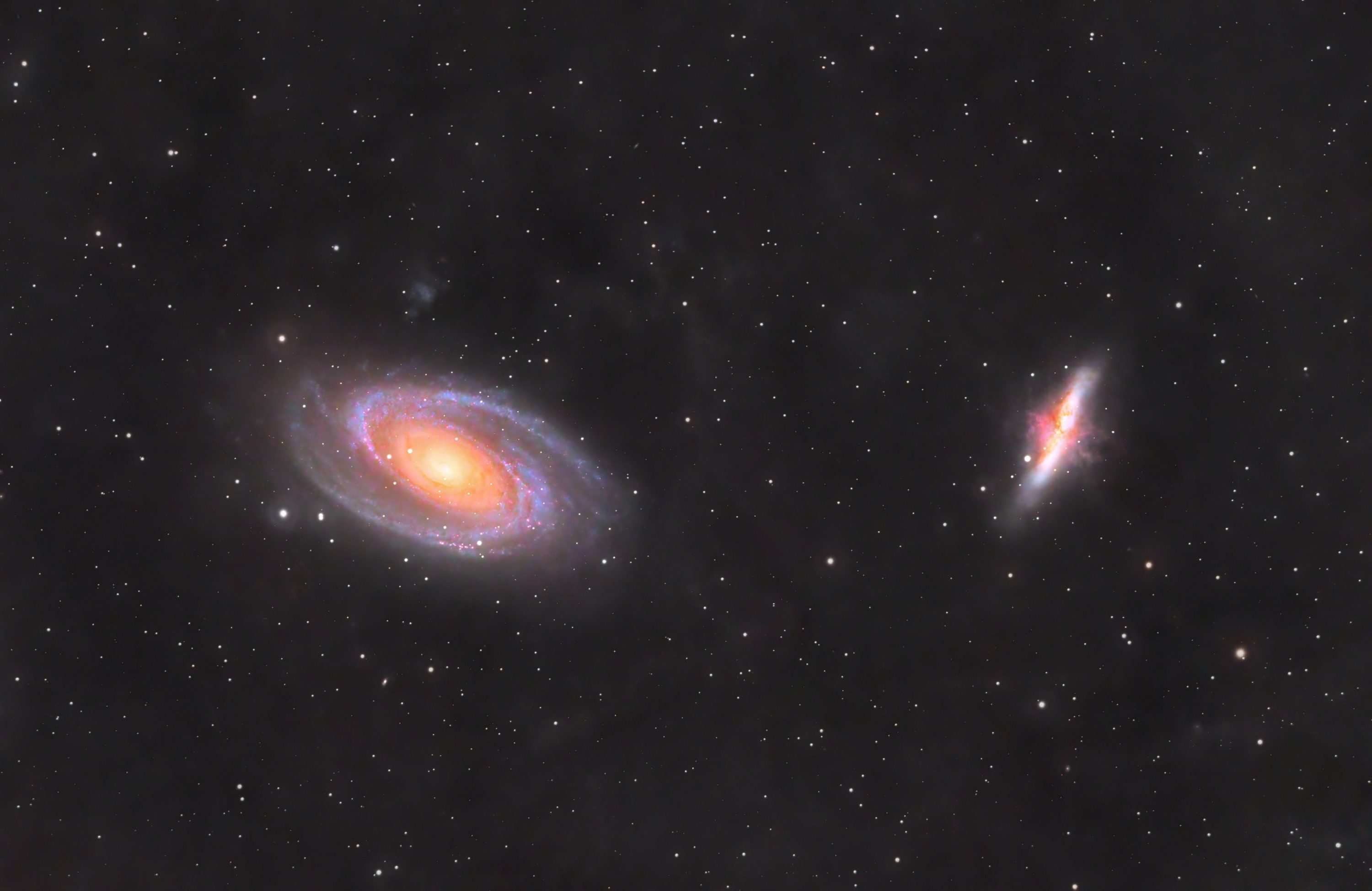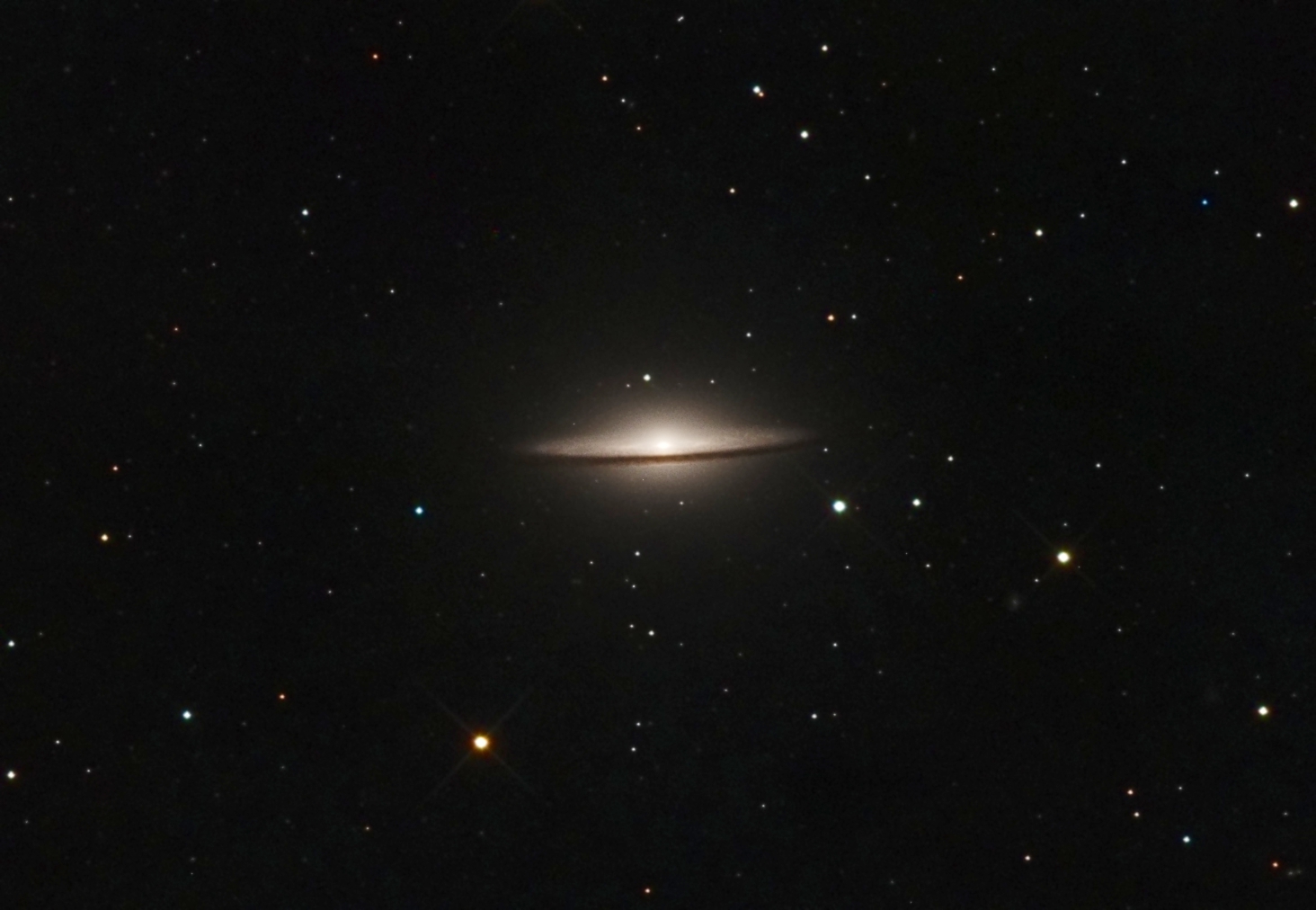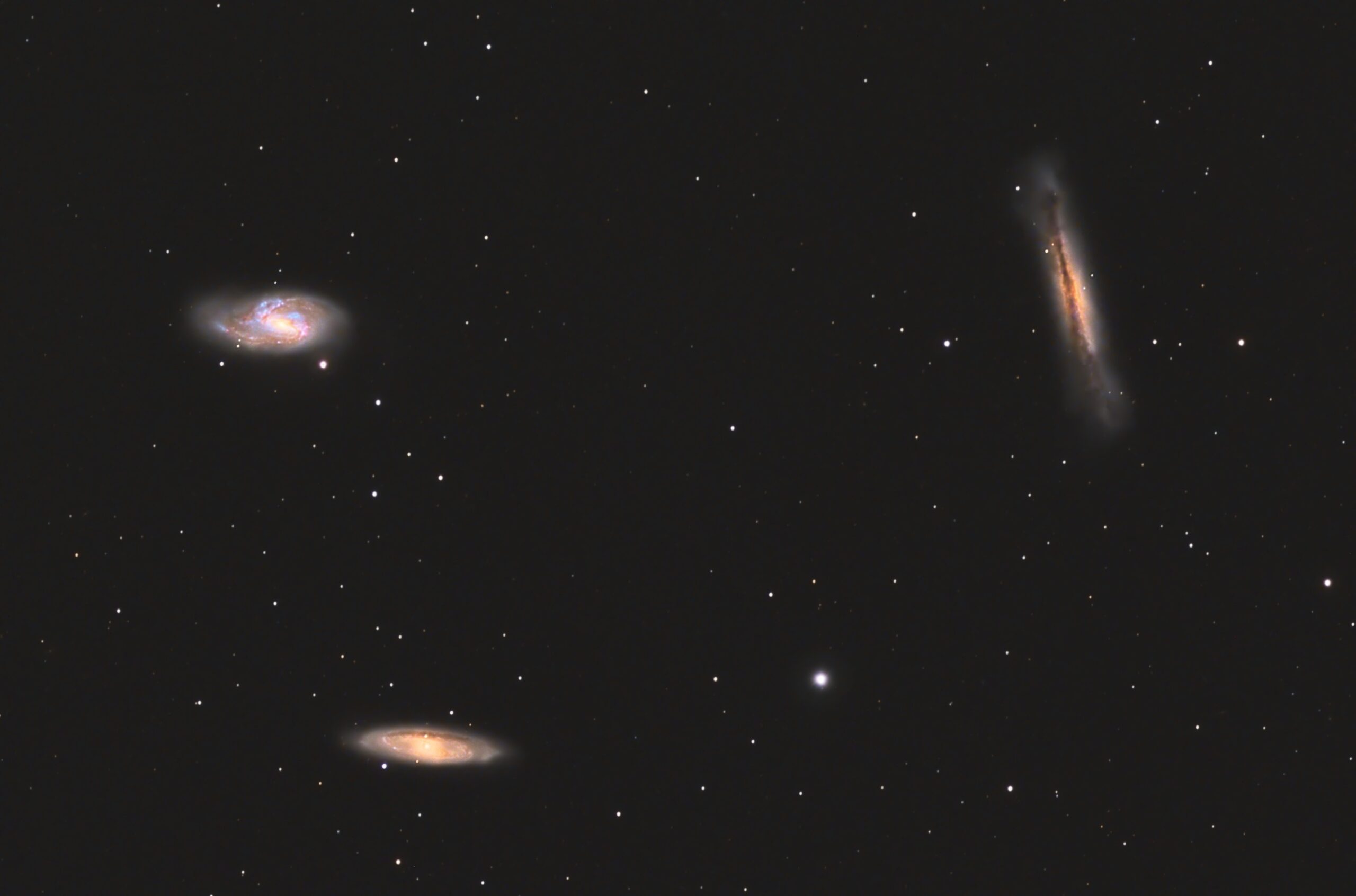No products in the cart.
As the spring season approaches, astrophotographers are eagerly anticipating the arrival of galaxy season. This is the time when the skies are still dark early in the evening and the galaxies are at their best in our night sky. With the right equipment and conditions, it’s possible to capture stunning images of these celestial objects. In this article, we’ll explore the top 5 deep sky targets for galaxy season and provide tips on how to image them.
M81 and M82
M81 and M82 are two galaxies located in the constellation Ursa Major. M81, also known as Bode’s Galaxy, is a spiral galaxy that is approximately 12 million light-years away. M82, on the other hand, is a starburst galaxy that is approximately 11.5 million light-years away. These two galaxies are often imaged together due to their close proximity in the sky.
For best results to image M81 and M82, you’ll need a telescope with a focal length of at least 500mm to 1000mm and a cooled astronomy camera that is capable of long exposures. A monochrome camera with a narrowband filter can also be used to capture the hydrogen alpha emissions from M82. The best time to image these galaxies is in April and May when they are highest in the sky.
The Whirlpool Galaxy (M51)
The Whirlpool Galaxy, also known as M51, is a spiral galaxy located in the constellation Canes Venatici. It is approximately 23 million light-years away and is one of the most famous galaxies in the night sky. It is notable for its striking spiral arms and the companion galaxy that is located next to it.
To image the Whirlpool Galaxy with best results, you’ll need a telescope with a focal length of at least 800mm and a cooled astronomy camera that is capable of long exposures. A OSC (One Shot Colour) like the ZWO ASI533MC Pro is an excellent choice. If using a monochrome camera like the QHY268M and a filter wheel, a narrowband filter can also be used to capture the hydrogen alpha emissions from the galaxy. The best time to image the Whirlpool Galaxy is in May and June when it is highest in the sky.
The Pinwheel Galaxy (M101)
The Pinwheel Galaxy, also known as M101, is a spiral galaxy located in the constellation Ursa Major. It is approximately 21 million light-years away and is one of the largest and brightest galaxies in the night sky. It is notable for its grand design spiral structure and the numerous HII regions that are located within it.
For best results to image the Pinwheel Galaxy, you’ll need a telescope with a focal length of at least 1000mm and a camera that is capable of long exposures. A narrowband filter can also be used to capture the hydrogen alpha emissions from the galaxy. The best time to image the Pinwheel Galaxy is in April and May when it is highest in the sky.
The Sombrero Galaxy (M104)
The Sombrero Galaxy, also known as M104, is a spiral galaxy located in the constellation Virgo. It is approximately 29 million light-years away and is notable for its distinctive shape. It is a type of galaxy known as a lenticular galaxy, which means it has a central bulge and a disk, but no spiral arms.
To image the Sombrero Galaxy, you’ll need a telescope with a focal length of at least 800mm and a camera that is capable of long exposures. A narrowband filter can also be used to capture the hydrogen alpha emissions from the galaxy. The best time to image the Sombrero Galaxy is in April and May when it is highest in the sky.
The Leo Triplet (M66 galaxy group)
The Leo Triplet is a group of three galaxies located in the constellation Leo. The group is made up of M65, M66, and NGC 3628, and they can be observed and imaged with a widefield telescope.
M65 and M66 are spiral galaxies, while NGC 3628 is an edge-on spiral galaxy. M65 and M66 are approximately 50,000 light-years in diameter, while NGC 3628 is larger at approximately 100,000 light-years in diameter.
Using a widefield telescope allows for all three galaxies to be captured in a single image. The Leo Triplet can be found in the constellation Leo, and it is visible in the northern hemisphere during the spring and early summer months. The best time to observe the Leo Triplet is during a new moon when the sky is darkest.
M66 is the largest and brightest of the three galaxies in the Leo Triplet. It has a bright central region and spiral arms that are visible in images taken with a widefield telescope. M65 is slightly smaller and has a more compact central region, while NGC 3628 appears as a thin edge-on spiral galaxy with a dark lane running through its center.

Long focal length telescopes and cooled astronomy cameras
Using a long focal length telescope and a cooled astronomy camera can significantly improve your astrophotography results for capturing fine details in galaxies. Let’s take a look at how a combination of a long focal length telescope like the Celestron Edge HD SCT or Starfield Optics GĖAR 115MM F/7 triplet Refractor and a cooled astronomy camera like the ZWO ASI 533MC or QHY268M CMOS camera can benefit your astrophotography.
First, let’s talk about the benefits of a long focal length telescope. A long focal length telescope has a narrower field of view, which allows you to capture more detail and magnification of your target. This is especially useful for imaging galaxies during galaxy season, as galaxies are generally very faint and require high magnification to capture details. With a long focal length telescope, you can capture a lot of detail on smaller areas of the sky, giving you better results.
Now, let’s talk about cooled astronomy cameras. A cooled astronomy camera like the ZWO ASI 533MC or QHY268M CMOS camera can significantly reduce the amount of noise in your images. By cooling the camera sensor, you reduce the amount of thermal noise generated by the camera, resulting in cleaner images. This is especially important when imaging faint targets like galaxies, as you want to capture as much detail as possible without adding any unnecessary noise.
When using a long focal length telescope and a cooled astronomy camera together, you can achieve even better results. The high magnification provided by the long focal length telescope allows you to capture more detail, while the cooled astronomy camera reduces the amount of noise in your images. This combination can produce stunning astrophotography results.
So, if you want to capture the best possible images of galaxies during galaxy season, consider using a long focal length telescope and a cooled astronomy camera like the ZWO ASI 533 or QHY268M CMOS camera. With the right equipment and techniques, you can produce stunning images that will impress even the most experienced astrophotographers.

Widefield telescopes
Using a widefield telescope for imaging galaxies, like the Starfield Optics Gear 90mm triplet refractor, can be a great way to capture stunning astrophotography, but it’s important to understand that a widefield telescope may not always provide the best resolution to resolve galaxy details.
A widefield telescope typically has a shorter focal length and a wider field of view, allowing you to capture a larger area of the sky in a single image. This can be very useful when imaging larger galaxies, such as the Andromeda Galaxy (M31), which is one of the most popular targets for widefield astrophotography. With a widefield telescope, you can capture the entire galaxy in one image, showing off its vast size and structure.
However, it’s important to note that a widefield telescope may not provide the best resolution to resolve galaxy details. Galaxies are incredibly complex structures, with intricate details and structures that require high magnification to capture. A widefield telescope may not be able to capture all of these details, as its shorter focal length and wider field of view may not provide enough magnification to resolve them.
Despite this limitation, there are still plenty of galaxies that are ideal for widefield telescope imaging. In addition to M31, the galaxies M81 and M82 are also great targets for widefield astrophotography. These galaxies are located close to each other in the night sky, making them a popular pair of targets for astrophotographers. They are also relatively large, making them well-suited for imaging with a widefield telescope.
When imaging galaxies with a widefield telescope, it’s important to keep in mind that the quality of your image will depend on several factors. The most important of these is the quality of your telescope and camera equipment. A high-quality telescope like Starfield Optics and cooled astronomy camera will allow you to capture sharper and more detailed images, even with a widefield telescope.
Another important factor is the location and conditions of your imaging site. Light pollution can be a major issue when imaging galaxies, as it can make it difficult to capture faint details. Choosing a dark site with clear skies and good seeing conditions can make a big difference in the quality of your images.
Conclusion
In conclusion, spring is a great time for astrophotographers to capture stunning images of galaxies in the northern hemisphere. Whether you choose to use a long focal length telescope or a widefield telescope with a dedicated astronomy camera, there are plenty of amazing galaxies to choose from. With the right equipment and techniques, you can capture detailed images of galaxies like M81, M82, M31, and even the Leo Triplet M66 galaxy group. So, get out there, explore the cosmos, and capture some breathtaking images of the galaxies this spring!

My story began more than 40 years ago looking up at the Moon with a small telescope my Father had. Encouraged by my parents, who bought me my very own telescope, a 4.5″ reflector, I began to explore the night sky from my family home backyard. Today I do astrophotography from my home in Kitchener, Ontario and also with remote telescopes located in New Mexico and Australia. Some of my images have won awards and have been featured online and in magazines.







Leave a comment...